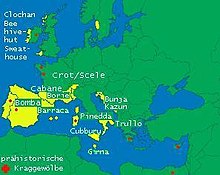Trim (Hvar)
The Trim is a small dry stone house with a stone cantilever vault that is from a Neolithic tradition. The shape has been preserved in the original building principle on the island of Hvar to this day .
The cultivation of the land around the settlements on the island of Hvar used to be much more extensive than it is today. These areas, which have already been largely abandoned, can still be recognized by the extensive dry stone walls, wine terraces and the remains of agricultural buildings that have already been overtaken by nature and are now often forest or scrubland.
The cultivation of the areas, which are often far away from the settlements, made it necessary to set up emergency shelters in the fields during seasonal work. Trims were therefore never built for a long stay, but solely out of necessity and interest. They served to protect the workers from bad weather, to accommodate equipment for cultivating the fields and occasionally (with a dwarf) as a shelter for livestock. Because of their location, some of the trims may only have been used to observe / guard the corridors. In the east of the island of Hvar (Sucuraj, Selca kod Bogomolje) the trims are also called Torijun.
Most of the trims that still exist today were built in the 19th century. You can still find them today on and in the fertile surroundings of settlements e.g. B. Stari Grader level, Zastražišće and Gdinj. But also far away from the settlements such as B. In the "Poljica" plateau south of the village of Svirce and often also on the former cultural landscapes that are now abandoned and reforested (e.g. Vrbanjske Rudine). On the south side of the island, however, there are hardly any trims today. That may have the reason that cultivation (especially viticulture) is more recent here and no longer falls into the heyday of Trimbaues (19th century). Trims can hardly be found in localities.
Most of the trims on the island of Hvar are circular in plan. This is the most stable shape, especially for the dome-shaped roof, that can be achieved with drywall (a construction without the use of mortar). Larger trims were often built in steps. This made their construction much easier and the maintenance and maintenance improved thanks to easier access to the upper areas and the roof.
The trim with the largest circular outer diameter of approx. 620 cm is the "Veli Trim Hora" in the Stari Grader plain. The highest trim is near the village of Vrisnik (Vrisnik-Trim-03) with a height of about 450 cm.
The wall thickness is often around 75 cm. The entrance to the mostly round interior is low (usually around 1 m high) and on average around 60 cm wide. The interior space usually has a diameter of 180 to 250 cm. However, some trims also have a circular inner diameter of 400 cm, such as the "Trim-60" north of Stari Grad. A trim in Vrisnik (Vrisnik-Trim-03) has the highest interior space with 420 cm, although this may have been a little higher in the past, as the dome top was later replaced by a concrete finish. Inside there are often wall niches ("ponare") that are used to store small items.
Many trims, especially those on the olive groves and vineyards that are still in use today, are still in use and are mostly in good condition. In some trims there are still remains of equipment, although they are already visibly deteriorating. However, some trims are already completely abandoned and their entrance area or the entire trim disappears in the bushes or under a thorn hedge.
Trims are evidence of artful folk architecture that was built with great effort and is worth preserving for posterity. All the more to thank those people who have recognized the treasure they have on their property and look after it accordingly.
There are more than 500 of these stone houses on the island of Hvar. Such buildings can also be found in Istria and Dalmatia under the names Kažun and Bunje . Similar buildings with the same technology and use can be found in France, Italy, Slovenia, Spain and Malta ( Girna ), but also in Ireland and Scotland and in parts of Switzerland.
research
Their archaeological , architectural and ethnological relevance have been researched since the mid- 19th century . The German scholar Gerhard Rohlfs researched structures with domed ceilings in Europe for more than 30 years . In 1957 he published the result in the book: Primitive Domed Buildings in Europe . It provides information about similar huts ( trullo ) in Italy , Sardinia , Spain , Portugal , France , Ireland , the Hebrides and other countries. By means of comparison, he showed how much old Europe was covered by dome-shaped ceiling structures.
See also
literature
- Gerhard Rohlfs : Primitive domed buildings in Europe (= Bavarian Academy of Sciences, Philosophical-Historical Class. Treatises. NF 43, ISSN 0005-710X ). Publishing house of the Bavarian Academy of Sciences, Munich 1957.
Web links
Individual evidence
- ↑ STARI GRAD - Trim "SG-TR-02, Veli trim Hora" . topohvar.at. Retrieved March 19, 2020.
- ↑ VRISNIK - Trim "VK-TR-03" . topohvar.at. Retrieved March 19, 2020.
